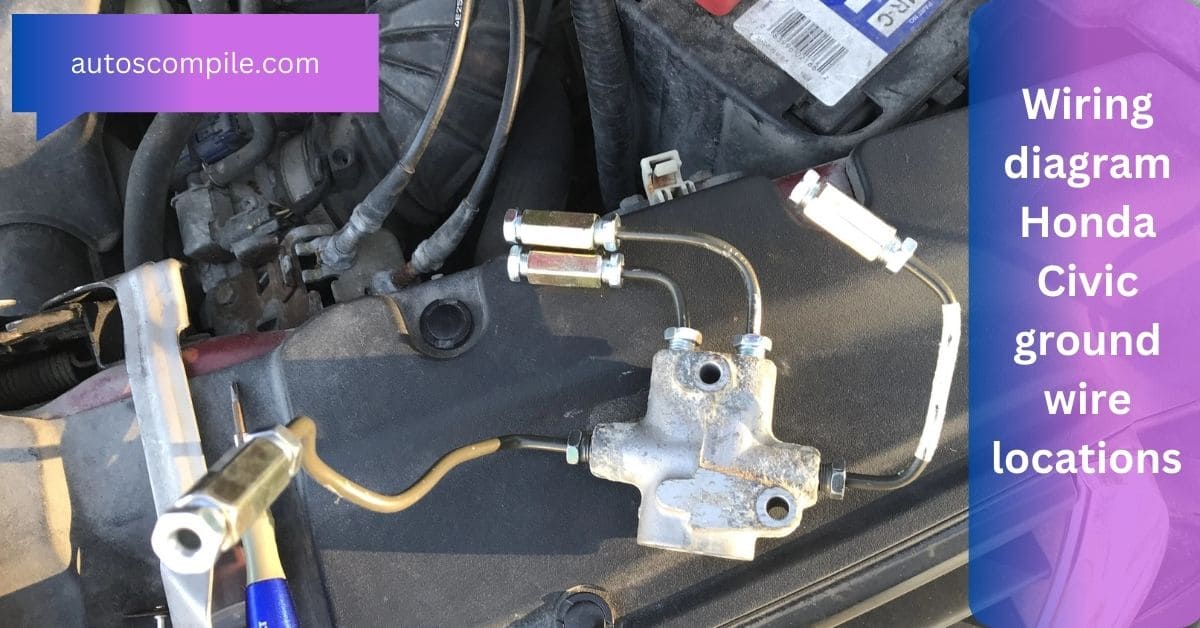“Checking my Wiring diagram Honda Civic ground wire locations made a huge difference no more flickering lights or sensor issues! Using a wiring diagram, I quickly found key spots like the battery and engine block, and a quick clean-up solved everything.”
Wiring diagram Honda Civic ground wire locations keep the electrical system stable, preventing issues like dim lights and faulty sensors. Key ground points include the battery, engine block, transmission, and ECU. Regular checks and cleaning ensure reliable performance.
Cleaning my Honda Civic’s ground wires, with the help of a wiring diagram, fixed the flickering lights and sensor issues for smoother performance.
What Are Ground Wires In A Honda Civic?
Ground wires are essential in a Honda Civic’s electrical system, providing a path for electrical current to return to the battery and complete circuits.
This grounding stabilizes electricity flow, prevents shorts, and supports consistent power to electronic components.Without proper grounding, issues like dim lights, unresponsive sensors, and malfunctioning electronics can occur, impacting the vehicle’s performance and safety.
Where Are The Ground Wires Located In A Honda Civic?
- Battery Ground: Attached to the chassis near the battery, this ground wire completes the battery’s negative circuit and provides a stable connection to the car’s frame.
- Engine Block Ground: Found on or near the engine block, this ground wire connects to the chassis, providing essential grounding for the engine’s electrical components.
- Transmission Ground: Located near the transmission housing, this ground supports transmission sensors and ensures smooth gear shifts.
- Chassis Grounds: These are distributed across the car’s body, often near headlights, under the dashboard, and at critical points for electronic components.
- ECU Ground: Near the Engine Control Unit (ECU), this ground stabilizes engine performance and sensor communication.
How To Identify Ground Wire Problems In A Honda Civic
To identify ground wire problems in a Honda Civic, watch for signs like dim headlights, warning lights, slow starts, or electronic malfunctions. These can indicate a grounding issue.
Testing with a multimeter for continuity at each ground point can confirm if a connection is loose, corroded, or damaged, helping pinpoint areas that need repair.
Detailed Wiring Diagram Explanation For Honda Civic Ground Locations:
1. Battery to Chassis Ground:
- Location: Runs from the battery’s negative terminal to a point on the car’s chassis, often near the battery itself.
- Purpose: This main ground point completes the circuit for the entire electrical system, stabilizing power from the battery to all components.
2. Engine Block Ground:
- Location: Typically attached to the lower part of the engine block or near the alternator.
- Purpose: Provides a return path for electrical components within the engine, supporting ignition, alternator function, and other engine electronics.
3. Transmission Ground:
- Location: Near the transmission housing, often connected to the chassis or engine block.
- Purpose: Ensures stable operation for transmission sensors and supports proper shifting by grounding the transmission’s electronic components.
4. Chassis Grounds:
- Location: Distributed throughout the vehicle, often near the headlights, under the dashboard, and around electronic modules.
- Purpose: These points ground various electronic systems (e.g., lighting, infotainment) to the car’s frame, preventing electrical interference and maintaining steady performance.
5. ECU (Engine Control Unit) Ground:
- Location: Near the ECU, typically mounted close to the firewall.
- Purpose: The ECU ground supports stable data and power for engine management and sensor communication, critical for engine performance.
Tools You Need To Check Honda Civic Ground Wire Locations:
- Multimeter: To check continuity and resistance.
- Wrench or Socket Set: To tighten or remove any bolts securing ground wires.
- Wire Brush or Sandpaper: For cleaning corrosion or dirt from connections.
- Dielectric Grease (optional): To prevent future corrosion.
Step-By-Step Guide To Check Honda Civic Ground Wire Locations:
1. Turn Off the Engine:
Ensure the vehicle is off and the key is removed to avoid any electrical accidents while working on the wiring.
2. Locate the Battery Ground:
- Find the Negative Terminal: The ground wire is attached to the negative terminal of the battery.
- Inspect the Connection: Ensure the wire is tightly secured to the chassis. Look for any signs of corrosion or damage.
- Test Continuity: Use a multimeter to check continuity from the negative terminal to the chassis to confirm the ground is intact.
3. Check the Engine Block Ground:
- Locate the Ground Point: Find the ground wire attached to the engine block, typically near the alternator or lower engine mount.
- Inspect the Ground: Ensure the wire is securely connected to the block and chassis, with no corrosion or looseness.
- Clean if Necessary: Use a wire brush to clean any corrosion, and reattach the ground wire firmly.
- Test with Multimeter: Check continuity to ensure a stable ground connection.
4. Inspect the Transmission Ground:
- Locate the Transmission Ground Wire: This is usually near the transmission case or engine block.
- Check for Secure Connection: Make sure the ground wire is firmly attached to the transmission and the chassis.
- Test Grounding: Use your multimeter to ensure proper continuity between the transmission and chassis.
5. Inspect Chassis Grounds:
- Identify Chassis Ground Locations: These are found around the vehicle near headlights, under the dashboard, and near electronic components.
- Tighten Loose Grounds: Check the bolts and make sure all connections are tight. Look for visible corrosion or dirt.
- Clean and Test: If needed, clean the connections and use a multimeter to check for continuity to the chassis.
6. Check the ECU Ground:
- Locate the ECU Ground: Find the ground wire near the ECU, which is typically mounted close to the firewall.
- Inspect and Clean: Ensure the wire is securely attached and free from corrosion. Clean the connection if necessary.
- Multimeter Test: Check continuity from the ECU ground to the chassis to confirm proper grounding.
7. Reassemble and Test:
- Reattach Any Ground Wires: After inspecting and cleaning, reattach any loose wires and tighten all connections.
- Test the Electrical System: Start the vehicle and check for any electrical issues such as flickering lights, dashboard warnings, or slow engine starts. If problems persist, double-check the grounds.
8. Apply Dielectric Grease (Optional):
- For future protection, apply dielectric grease to the ground wire connections to prevent corrosion and ensure long-lasting, stable grounds.
Common Issues With Ground Wires In A Honda Civic:
1. Corrosion:
Over time, ground wires can corrode due to exposure to moisture, salt, or dirt. This corrosion can cause poor electrical connections, leading to flickering lights, engine performance issues, or failure of electrical components.
2. Loose Connections:
Ground wires that are not tightly secured can create intermittent electrical connections, causing problems like dim headlights, dashboard warning lights, or difficulty starting the engine.
3. Damaged Wires:
Wires can become frayed, cracked, or broken, often due to age, wear, or improper handling. Damaged wires may lead to a complete failure of the grounding system, causing multiple electrical malfunctions in the car.
4. Improper Grounding:
If ground wires are not correctly attached to the chassis or engine block, it can create a weak or unstable electrical system. This might cause issues such as erratic sensor readings or malfunctioning electrical components.
5. Grounding Loops:
In some cases, poor or multiple grounding points can create ground loops, where electrical interference causes issues with the vehicle’s electronics. This can lead to problems like distorted sound in the audio system or incorrect readings from sensors.
6. Worn-Out Ground Straps:
Ground straps that connect major components like the battery, engine, and chassis can wear out over time. If these straps become loose or lose their conductivity, the vehicle may experience power loss or irregular behavior in electrical systems.
Tips For Maintaining Ground Wires In A Honda Civic:
- Regular Inspection: Check ground connections for corrosion, loose bolts, or wear. Inspect the battery, engine block, transmission, and ECU grounds.
- Clean Ground Points: Use a wire brush to clean any corrosion, and apply dielectric grease to protect connections.
- Tighten Connections: Ensure ground wires are tightly secured to prevent electrical issues like dim lights or faulty sensors.
- Check for Damage: Look for frayed or cracked wires. Replace any damaged wires to maintain proper grounding.
- Monitor Electrical Performance: Watch for signs like dim headlights or slow starts, which may indicate grounding issues.
Faqs:
1. What Problems Can Arise from a Loose Battery Ground?
A loose battery ground can cause dimming lights, engine misfires, or an intermittent electrical system, affecting overall vehicle performance.
2. Is a Ground Wire the Same as a Ground Strap?
They are similar, but ground straps are usually thicker and are used to connect major components like the engine block and chassis.
3. Can Bad Grounds Cause Radio Interference in a Honda Civic?
Yes, poor grounding can create ground loops or noise, leading to audio distortion or radio interference.
4. Why Does My Honda Civic’s Ground Wire Heat Up?
Overheating in a ground wire indicates high resistance, possibly due to a loose or corroded connection, which should be inspected immediately.
Conclusion:
Wiring diagram Honda Civic ground wire locations are essential for keeping your Honda Civic’s electrical systems running smoothly. Knowing where to find and how to check these ground points like the battery, engine block, transmission, and ECU can help prevent issues like dim headlights or sensor glitches. Regular inspections and simple upkeep, like cleaning connections and applying grease, can protect your electrical system and keep your Civic running reliably.

